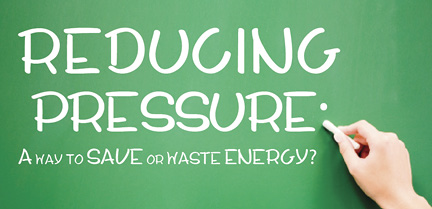Reducing Pressure: A Way to Save or Waste Energy?

If you are a pneumatics person, you will be thinking of a pressure regulator; the hydraulic people among us will be thinking of pressure-reducing valves. In concept, the two controls are similar, but the way they affect the energy requirements is quite different. In hydraulics, the pressure-reducing valve is an energy waster; in pneumatics, it can be an energy saver.
In both systems, the valve is normally open (passing). This is important to remember. I have seen examples of applications where this has not been considered in both hydraulic and pneumatic systems with some surprising results, not related to energy.
On the hydraulic side, I recently had to deal with an application where a cylinder had to move a wheeled carriage horizontally. The load on the carriage varied from about 6,000 pounds to 34,000 pounds. The problem was that the carriage system would abruptly stop at the end of its travel. The shock would send a shudder through the mechanical components, producing a nightmare of mechanical problems needing repair. Someone had decided to add a pressure-reducing valve to the circuit to reduce the shock load. The idea was that, by reducing the pressure on the cylinder, it would not have such an impact when it stopped. The system pressure was set at 190 bar (2800 psi), but it only required 50 bar (750 psi) to accelerate the load. The pressure-reducing valve was set at 50 bar and the system was operated. BANG! The carriage slammed at the end of its travel as before. The reduced pressure was reset to 40 bar. The carriage took longer to come up to speed, but when it came to the end…BANG! So what was going on?
I can see that some of you are grinning because you have gone through this same thing yourselves, but don’t get cocky. We all had to learn this at some point. I made a similar mistake in a clamp circuit, but we can talk about that later.
Here is the problem. Remember, the pressure reducing valve is a what? That’s right, a normally open (passing) valve. The reducing valve was in the pressure line to the directional valve. When the valve was shifted, reduced pressure was directed to the cylinder and affected the rate of acceleration. However, once the carriage reached its top speed, it required less than the reduced setting to maintain the speed, and so the pressure reducing valve did what? It opened up…all the way. When the carriage came to the end of its travel, it hit at full speed, and there was a sudden spike in pressure as system pressure was felt in the line. Immediately after the carriage stopped, the pressure-reducing valve modulated to reduce the pressure, but the damage was already done. It was like putting on the brakes right after you hit the wall.
On the pneumatic side, I was called in to troubleshoot a system where some test tube grippers were failing to release the tubes. The components were all safely protected in a Plexiglas enclosure. The problem only occurred after someone opened a particular door in the enclosure that had an “E” Stop function. If any other door was opened or if the system was shut down normally, everything operated properly. But, if someone opened that one door while the grippers where holding the tubes and then closed the door and restarted the system, some of the grippers would not release. The valve manufacturer was pointing fingers at the gripper people and the gripper people were pointing back at the valve folks, and the owner of the machine was losing production and just wanted it to be fixed.
The plant air system operated at 7 bar (100 psig). The grippers were designed to work at 4 bar (60 psig). There was a pressure regulator in the supply line set at 4 bar. The FRL had a built-in safety unloading valve tied into the “E” Stop circuit that cut off the air supply and vented the system. The directional control valves for the grippers were all solenoid operated and remained in the last commanded position. The grippers were double-acting: power to close, power to open.
Once again we ask, “What is going on here?” At the time, it was a real head-scratcher, but in retrospect, it is pretty clear. The key is that a pressure regulator is a normally open (passing) valve. During normal shutdown, the pressure to the system remained available at 4 bar, so even if someone opened another door that stopped the motions, the grippers never saw more than their allotted 4 bar. However, when someone activated the “E” stop in the middle of an operation, the system pressure was vented and the pressure regulator–you guessed it–opened up. Upon closing the door and de-activating the “E” Stop, 7 bar of pressure zipped through the open regulator and sent a shock wave traveling at the speed of sound through the directional valves and into the grippers, causing them to jam even tighter against the test tubes. A few milliseconds later, the pressure regulator sensed the change and modulated to reduce the pressure to 4 bar. When the grippers were directed to release the test tubes, some were jammed so tight that it required more than 4 bar to open them, and so they were unable to release the tubes.
For the hydraulic system, the answer was to replace the bang-bang valve with a proportional valve that allowed us to softly start and stop the carriage. On the pneumatic side, the answer was to supply a regulator that is specifically designed to gradually increase the pressure in a system.
Now, as I was going to say before all this discussion about the function of these regulators, there is an energy aspect to both hydraulics and pneumatics; one negative and one positive. Hydraulically, a pressure-reducing valve can give the illusion of conserving energy because, at the actuator, we have less pressure and would appear to be using less energy. In reality, we are using more energy on two counts. First, remember that whenever there is a pressure drop in a hydraulic system, there has to be flow. Without flow, we have a static situation and pressure would be equal everywhere in the system. Whenever we have flow and a drop in pressure that does not produce useful work, the energy is lost in the form of heat. If we have a system that provides 10 gpm at 1714 psi and add a pressure-reducing valve to make only 857 psi available to the actuator, 5 hp will be lost in Btu’s that will have to be removed from the system. Second, even if the load is static, as in a clamp system, there is a constant flow through the drain line going from system pressure to tank. The pressure-reducing valve is one of the hot spots for energy loss.
Pneumatically, the pressure regulator is an energy saver. We pointed out in an earlier article [“Flow Control: If in Doubt…Think About Energy” (January/February 2009)] that we store our pneumatic energy in the form of pressurized air molecules stuffed in a receiver. We conserve on energy when we only use as many air molecules as necessary to do the job. The more molecules we stuff into a cylinder, the higher the pressure will be and the greater the available force. If we allow a cylinder to go to the end of its stroke and then continue to add more molecules, the pressure will build with no useful purpose and we will squander our reserve of energy. By properly setting the pressure regulator, we limit the number of molecules allowed into the actuator to what is required to produce the needed pressure.
Now, some of you are thinking, “Just stick a flow control valve in the line and that will reduce the amount of air that is used, right?” Wrong! The flow control limits how fast the molecules get stuffed into the actuator. It is the regulator that determines how many air molecules are actually used.
Hydraulically, I am not suggesting that we stop using pressure-reducing valves. I am simply pointing out that we need to understand exactly how they work and use them correctly, knowing that they are always a source of energy loss.
Pneumatically, I am suggesting that we start using more pressure regulators. They are a neglected item in our arsenal of energy-saving devices.



If pressure required is:
2 Bars 800 m3 /hr
5 bars 200 m3/hr
Compressors produce air at 7 bar pressure.
Since 80% energy is lost in the share of heat. Don’t you think using compressor at 2 bars and 5 bars separate systems will be more energy efficient?